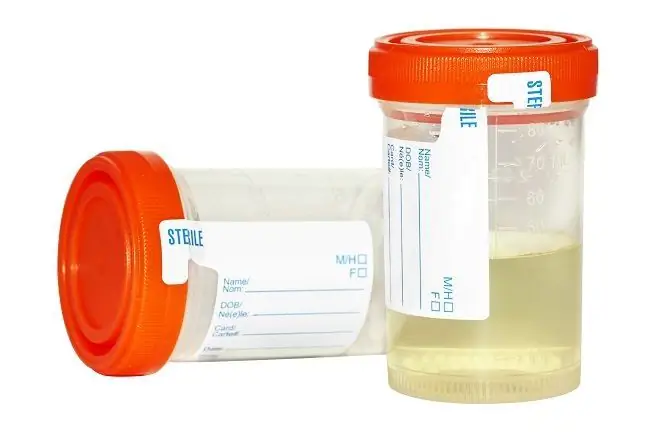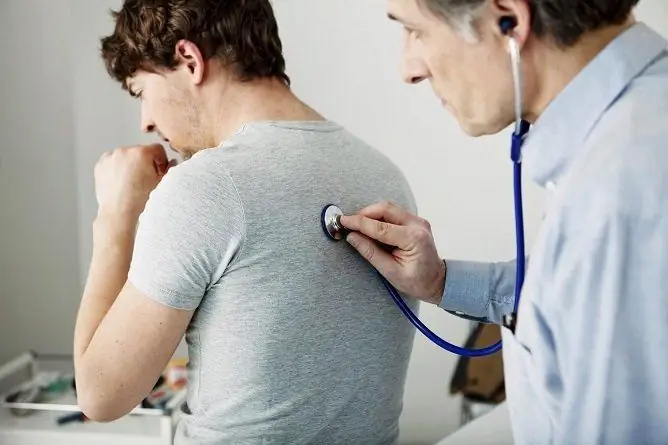- Author Rachel Wainwright [email protected].
- Public 2024-01-15 19:51.
- Last modified 2025-11-02 20:14.
Left-sided pneumonia: causes, symptoms, treatment
The content of the article:
-
How does the disease arise
Differences between right-sided and left-sided pneumonia
-
How does pneumonia manifest
-
The main symptoms
- Typical syndrome
- Atypical syndrome
- Signs of the disease depending on the pathogen
-
- Diagnostics
-
Treatment of left-sided pneumonia
- Antibiotic therapy
- Additional therapies
- Video
Left-sided pneumonia is much less common than right-sided inflammation. This form of the disease is more difficult to treat and is considered much more dangerous. Approximately 5% of cases of community-acquired pneumonia are fatal, with inflammation of the left lung accounting for the majority.

The development of left-sided pneumonia is less common than right-sided pneumonia
The symptomatology of pathology in adults and children is determined by the volume of the lesion, the pathogen, the general condition of the patient. Symptoms of the disease can be pronounced or practically absent. The diagnosis is established by a pulmonologist.
How does the disease arise
The lungs are a spongy, soft, conical paired organ. They provide respiration, resulting in the exchange of oxygen and carbon dioxide.
Three lobes form the right lung, and two lobes on the left. The shares are divided into smaller structures - segments.
The inflammatory process in most cases occurs only in the right or only in the left lung. In this case, the defeat can:
- occupy a small focus (focal form);
- localize only in one or several segments (segmental and polysegmental form);
- spread to one lobe (lower lobe and upper lobe form);
- apply to all shares (share form).
When the whole lung is involved in inflammation, they speak of total pneumonia.
Right-sided inflammation most often affects the II, VI, X segments, if the process has developed on the left - VI, VIII, IX, X segments.
Differences between right-sided and left-sided pneumonia
Pneumonia of the left lung is less common than the right one, which is associated with the peculiarities of the anatomical structure of the left bronchial tree.

The lungs consist of lobes divided into segments
The left bronchus is narrower than the right one, and therefore it is less well drained. Due to the weaker blood circulation, the drugs do not reach the inflamed area in full, which complicates therapy and, as a result, the disease is delayed, often leading to the development of complications.
The most common pathogens of pathology - pneumococci, staphylococci and Haemophilus influenzae - usually cause the development of right-sided pneumonia, because, due to the anatomical structure, they penetrate into it easier and faster.
Therefore, most often, inflammation of the left lung is associated with atypical pathogens, and also occurs against a background of weakened immunity.
How does pneumonia manifest
The main symptoms
The clinical picture of the disease is determined by the amount of damage to the lung tissue, the severity of the course of the disease, the virulence of the pathogen, the age of the patient, the resistance of the microorganism, the presence of concomitant diseases and other factors.
The manifestations of primary community-acquired pneumonia (developed outside the walls of a hospital) are conventionally divided into two syndromes.
Typical syndrome
The pathology is characterized by an acute onset of fever with a sharp increase in body temperature, cough with purulent sputum, in some cases the development of chest pain, signs of compaction of lung tissue.

Streptococcus pneumoniae is characterized by the development of a typical pneumonia syndrome
These signs are most typical for Streptococcus pneumoniae, but can also be observed in the presence of pathogens such as Haemophilus influenzae, mixed aerobic and anaerobic microflora of the oral cavity.
Atypical syndrome
The disease develops gradually, with a predominance of extrapulmonary symptoms (in the form of headache and muscle pain, weakness, disorders of the digestive system). The X-ray shows minimal signs of physical examination.

If the causative agent of the disease is Legionella pneumophila, the disease usually develops gradually
Usually, such a course is typical for Mycoplasma pneumoniae, Legionella pneumophila, Klebsiella pneumoniae, anaerobes of the oral cavity, Chlamydia psittaci, Francisella tularensis, Histoplasma capsulatum.
Signs of the disease depending on the pathogen
Features of the course of pneumonia, depending on the pathogen:
| Causative agent | Clinical features |
| Mycoplasma | Complications of the disease can be erythema multiforme, hemolytic anemia, bullous inflammation of the tympanic membrane, encephalitis, and transverse myelitis. |
| Legionella pneumophila | The disease is often accompanied by symptoms such as impaired consciousness, kidney and liver dysfunction, severe hyponatremia |
| Chlamydia | Pneumonia may be accompanied by hoarseness, sore throat; wheezing is a fairly common symptom |
| Staphylococcus aureus (with hematogenous transmission of infection) | The main manifestations of pneumonia can only be fever and shortness of breath, initially the inflammatory response is limited to the pulmonary interstitium. Other characteristic symptoms - coughing up sputum and signs of hardening of the lung tissue - occur only after reaching a bronchial infection |
| Nocardia | The disease is often complicated by metastatic lesions of the central nervous system and skin |
Viral pneumonia is usually associated with pathogens such as:
- influenza virus: in most cases during a winter epidemic;
- measles or chickenpox viruses: in combination with a characteristic rash;
- respiratory syncytial virus: usually in immunosuppressed individuals and in children;
- cytomegalovirus: in HIV-infected patients or during immunosuppressive therapy associated with organ transplantation.
Primary viral pneumonia is characterized by atypical manifestations, including chills, dry, unproductive cough, fever, and predominantly extrapulmonary symptoms. Due to impaired airway barrier function, measles, influenza and chickenpox predispose to the development of secondary bacterial pneumonia.
The development of a secondary bacterial infection can occur after a viral infection without interruption or after several days, during which there is a decrease in symptoms.
Diagnostics
With the left-sided localization of the inflammatory process, the doctor, upon examination, notes the lag of the left half of the chest in breathing, the shortening of the percussion sound over the affected area of the lung. When performing auscultation over the left lung, fine bubbling rales and crepitus are heard.

Auscultation is of great diagnostic value
The main diagnostic method is X-ray examination. On the roentgenogram, depending on the localization of the process, foci of infiltration are visible in the upper or lower lobe.
If indicated, additional multispiral computed tomography and bronchoscopy can be prescribed.
Identification of the pathogen is carried out by bacteriological examination of sputum.
Treatment of left-sided pneumonia
Treatment of left-sided pneumonia requires an integrated approach. The main goals of therapy:
- destruction of the causative agent of the disease;
- improvement of the drainage function of the bronchi;
- restoration of pulmonary and general resistance.
Antibiotic therapy
The treatment is based on the use of antibacterial drugs. To minimize the likelihood of complications, antibiotic therapy should be started as early as possible. The choice of the drug, as well as the determination of how many times a day and in what dose to take it, is carried out by the doctor.
In the treatment of mild to moderate pneumonia without concomitant diseases, the drugs of choice are aminopenicillins and modern macrolides. In the presence of concomitant diseases, beta-lactams (cephalosporins II - III generation, amoxiclav) are prescribed in combination with new generation macrolides.
They also carry out monotherapy with respiratory fluoroquinolones of III-IV generations, which include moxifloxacin and levofloxacin. Treatment can be done at home under medical supervision. When the condition improves, you cannot change the treatment regimen on your own, especially this applies to the treatment of children, including infants, and the elderly.

Hospitalization is indicated in cases of high risk of complications
In a severe course of the disease, as well as in patients with moderate pneumonia, with aggravating risk factors, hospitalization is required. In such cases, broad-spectrum antibiotics are administered parenterally (intravenously or intramuscularly). First-line drugs include protected aminopenicillins or modern macrolides.
In case of insufficient effectiveness, alternative agents are prescribed: cephalosporins of the II and III generations in combination with modern macrolides, respiratory fluoroquinolones of the III-IV generations.
Additional therapies
In addition to antibiotic therapy, mucolytic drugs are used, the action of which is aimed at thinning sputum and stimulating the activity of the cilia of the ciliated epithelium. In some cases, bronchodilators are indicated.
To reduce the severity of intoxication and remove toxins from the body, saline solutions, 5% glucose solution, albumin are introduced. In order to increase the general reactivity of the body, immunocorrective and immunosubstituting drugs are prescribed.

In order to improve the drainage function of the bronchi, physiotherapy exercises are indicated.
Non-drug therapy methods are aimed at improving the drainage function of the bronchi. These include:
- massage;
- abundant alkaline warm drink;
- physiotherapy.
Since the development of left-sided pneumonia is closely associated with a decrease in the immune response, an increase in the body's resistance plays an important role.
Video
We offer for viewing a video on the topic of the article.

Anna Kozlova Medical journalist About the author
Education: Rostov State Medical University, specialty "General Medicine".
Found a mistake in the text? Select it and press Ctrl + Enter.






